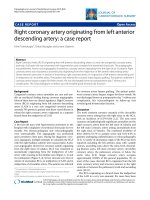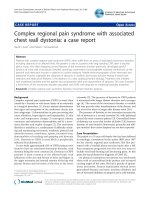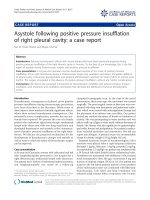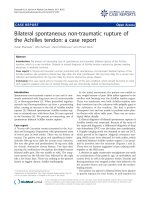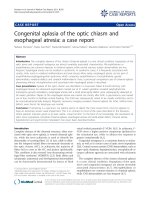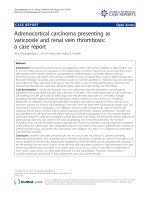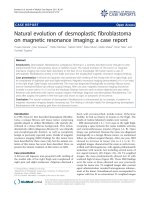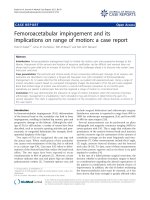Báo cáo y học: " Pulmonary fibrosis secondary to siderosis causing symptomatic respiratory disease: a case report" pptx
Bạn đang xem bản rút gọn của tài liệu. Xem và tải ngay bản đầy đủ của tài liệu tại đây (705.76 KB, 3 trang )
BioMed Central
Page 1 of 3
(page number not for citation purposes)
Journal of Medical Case Reports
Open Access
Case report
Pulmonary fibrosis secondary to siderosis causing symptomatic
respiratory disease: a case report
Liam M McCormick*
1
, Martin Goddard
2
and Ravi Mahadeva
1
Address:
1
Department of Respiratory Medicine, Addenbrooke's NHS Trust, Hills Road, Cambridge CB2 2QQ, UK and
2
Department of Pathology,
Papworth Hospital, Papworth Everard, Cambridge CB23 3RE, UK
Email: Liam M McCormick* - ; Martin Goddard - ;
Ravi Mahadeva -
* Corresponding author
Abstract
Introduction: Pulmonary siderosis secondary to the inhalation of iron compounds is a rare
condition which, despite striking radiological and histopathological features, has not traditionally
been associated with symptoms or functional impairment. Although not the first of its kind, we
present an unusual case of pulmonary siderosis with symptomatic respiratory disease, most likely
secondary to associated fibrosis.
Case presentation: A 66-year-old Caucasian man was referred to the outpatient clinic with a 2-
year history of exertional breathlessness. He had worked as an engineer for 20 years where he did
a significant amount of welding but always wore a face shield. Clinical, radiological and histological
features were consistent with a diagnosis of pulmonary siderosis, with associated fibrosis, most
likely related to his occupational welding history.
Conclusion: Our report illustrates that symptomatic respiratory disease due to mild
peribronchiolar fibrosis can occur with pulmonary siderosis despite wearing a mask. Furthermore,
it reinforces the need for all clinicians to compile a detailed occupational history in individuals
presenting with breathlessness.
Introduction
Pulmonary siderosis secondary to the inhalation of iron
compounds is a rare condition which was first described
in 1936 [1]. Despite striking radiological and histopatho-
logical features, it has traditionally been classified as a
'benign pneumoconiosis' [2] because of the absence of
associated symptoms, functional impairment or pulmo-
nary fibrosis [3]. Uncommonly, however, symptomatic
disease with interstitial fibrosis has been described in arc
welders [4]. We present an unusual case of pulmonary
siderosis with symptomatic respiratory disease, most
likely secondary to associated fibrosis.
Case presentation
A 66-year-old Caucasian man was referred to the outpa-
tient clinic with a 2-year history of exertional breathless-
ness. He had no other respiratory symptoms, had never
smoked and was not aware of any previous asbestos expo-
sure. He was not on any medication and had no allergies.
He had worked as an engineer for 20 years where he did a
significant amount of welding but always wore a face
shield. A review of systems was unremarkable.
On examination, he was not clubbed or cyanosed, and his
chest was clear to auscultation. Pulmonary function tests
Published: 5 August 2008
Journal of Medical Case Reports 2008, 2:257 doi:10.1186/1752-1947-2-257
Received: 23 June 2007
Accepted: 5 August 2008
This article is available from: />© 2008 McCormick et al; licensee BioMed Central Ltd.
This is an Open Access article distributed under the terms of the Creative Commons Attribution License ( />),
which permits unrestricted use, distribution, and reproduction in any medium, provided the original work is properly cited.
Journal of Medical Case Reports 2008, 2:257 />Page 2 of 3
(page number not for citation purposes)
showed a moderately severe obstructive defect, gas trap-
ping and a significantly reduced gas transfer factor: forced
expiratory volume in 1 second (FEV1) 1.58 (49.1%); vital
capacity (VC) maximum 3.0 (75.9%); FEV1/VC maxi-
mum 52.6%; total lung capacity (TLC) 7.2 (100%); resid-
ual volume (RV) 4.3 (157%); RV/TLC ratio 140.3%;
carbon monoxide transfer factor 3.57 (44.0%); carbon
monoxide transfer coefficient 0.77 (66.8%). His resting
oxygen saturations were 95% on room air; however, he
desaturated to 89% after 4 minutes of walking, which was
associated with a peak modified Borg score (perceived
breathlessness score) of three, indicating moderate
breathlessness. A chest radiograph showed diffuse gener-
alised reticular nodular shadowing with a suggestion of
enlarged hila (Figure 1a). Computed tomography scan-
ning revealed multiple small nodular opacities through-
out both lungs, predominantly in the mid and upper
zones (Figure 1b). Transbronchial biopsies were non-
diagnostic, therefore video-assisted thoracoscopic lung
biopsy was performed. Microscopic examination of these
specimens showed marked deposition of coarse iron gran-
ules in a centrilobular distribution, with foci of associated
fibrosis (Figures 2 and 3). The appearances were consist-
ent with pulmonary siderosis most likely related to his
Chest radiograph and computed tomographyFigure 1
Chest radiograph and computed tomography. (a)
Chest radiograph demonstrating diffuse generalised reticular
nodular shadowing. (b) Chest computed tomography scan
showing bilateral tiny nodular opacities throughout both lung
fields predominantly in the mid and upper zones.
A
B
Histological AnalysisFigure 2
Histological Analysis. (A) Low-power (×100) micrograph
showing pigment accumulation in an interstitial peribroncho-
vascular distribution. (B) Higher-power (×200) view showing
pigment in the interstitium around the airway; the alveolar
air spaces are empty. (C) High-power (×400) view showing
the 'golden granules' of haemosiderin.
A
B
C
Journal of Medical Case Reports 2008, 2:257 />Page 3 of 3
(page number not for citation purposes)
occupational welding history. In 3 years of follow-up his
lung function and chest radiograph have not progressed.
Discussion
Inhalation of iron compounds occurs commonly in paint
factories, during welding and steelmaking, and at various
stages of iron mining and iron refining. Doig and
McLaughlin first described 'welders' siderosis' in 1936
when they carried out a prospective study examining the
clinical and chest radiological characteristics of 16 electric
arc welders [1]. All but one of these original subjects were
followed for 9 years: four of these demonstrated progres-
sive radiographic reticular changes, nine showed no radi-
ographic changes, and in two men (both of whom had
spent significantly less time welding), there was evidence
of at least partial resolution of the initial radiographic
opacities [3]. All subjects, however, remained in good
health, leading to the conclusion that siderosis (in its pure
form) was not associated with respiratory symptoms or
functional impairment. This view was supported by sub-
sequent pathological investigations of the lungs of sub-
jects occupationally exposed to iron oxide fumes, which
did not demonstrate any evidence of pulmonary fibrosis
[3]. As a result, the apparently inert nature of iron com-
pounds led to the classification of pulmonary siderosis as
a 'benign pneumoconiosis' [2].
Nevertheless, symptomatic disease with interstitial fibro-
sis has been described in arc welders [4]. Some authors
have postulated that these rare cases are secondary to con-
comitant inhalation of silicates or asbestos that can occur
in many occupations associated with exposure to iron [4].
However, Funahashi et al. challenged this view after inves-
tigating 10 symptomatic welders and performing energy
dispersive X-ray analysis on lung tissue for elemental con-
tent [5]. Despite demonstrating restrictive defects in seven
of their patients, and mild to moderate airway obstruction
in a further two, they found no difference between the
pulmonary silicon content of patients with symptomatic
'welders' pneumoconiosis' and that of age-matched con-
trol lungs [5]. Some degree of parenchymal fibrosis was
present in all patients, and in 50%, this fibrosis was con-
sidered moderate to marked. As many of the iron-contain-
ing particles were seen in fibrotic alveolar septa, it was
postulated that the fibrosis was a reaction to these parti-
cles rather than the co-existing silicosis [5].
Conclusion
Our report illustrates that symptomatic respiratory disease
due to mild peribronchiolar fibrosis can occur with pul-
monary siderosis despite wearing a mask. Furthermore, it
reinforces the need to compile a detailed occupational
history in individuals with respiratory disease. It is partic-
ularly important to obtain an accurate diagnosis of inter-
stitial shadowing on chest radiograph as pulmonary
siderosis in our patient had a relatively good prognosis
compared with other interstitial and small airway disor-
ders.
Abbreviations
FEV1: forced expiratory volume in 1 second; RV: residual
volume; TLC: total lung capacity; VC: vital capacity.
Competing interests
The authors declare that they have no competing interests.
Authors' contributions
LM participated in the design and coordination of the case
report and drafted the manuscript. MG acquired, analysed
and reported on the histopathological slides. RM con-
ceived of the case report, participated in its design and
coordination, and revised it critically for important intel-
lectual content. All authors read and approved the final
manuscript.
Consent
Written informed consent was obtained from the patient
for publication of this case report and accompanying
images. A copy of the written consent is available for
review by the Editor-in-Chief of this journal.
References
1. Doig AT, McLaughlin AIG: X-ray appearances of the lungs of
electric arc welders. Lancet 1936, 1:771-775.
2. Billings CG, Howard P: Occupational siderosis and welders'
lung: a review. Monaldi Arch Chest Dis 1993, 48:304-314.
3. Doig AT, McLaughlin AIG: Clearing of X-ray shadows in welders'
siderosis. Lancet 1948, 1:789-791.
4. Nemery B: Metal toxicity and the respiratory tract. Eur Respir
J 1990, 3:202-219.
5. Funahashi A, Schlueter DP, Pintar K, Bemis EL, Siegesmund KA:
Welders' pneumoconiosis: tissue elemental microanalysis by
energy dispersive X-ray analysis. Br J Ind Med 1988, 45:14-18.
Histology – Iron and Collagen StainsFigure 3
Histology – Iron and Collagen Stains. (A) Perl Prussian
blue stain (×200) confirming deposition of iron. (B) High-
power elastic van Gieson collagen stain (red) demonstrating
significant fibrosis.
A B

